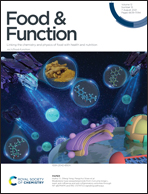Bisabolane-type sesquiterpenoids from Curcuma longa L. exert anti-influenza and anti-inflammatory activities through NF-κB/MAPK and RIG-1/STAT1/2 signaling pathways†
Abstract
Influenza is a viral respiratory illness that causes seasonal epidemics and occasional pandemics. Disease severity may be contributed by influenza virus-induced cytokine dysregulation. The study was designed to investigate the isolation and identification of bisabolane-type sesquiterpenoids from Curcuma longa L., their antiviral and anti-inflammatory activities against H1N1 and their potential role in regulating host immune response in vitro. A pair of new bisabolane-type sesquiterpenoids, (6S,7S)-3-hydroxy-3-hydroxymethylbisabola-1,10-diene-9-one (18) together with seventeen known analogs (1–17), was isolated and elucidated from Curcuma longa L. Compounds 2, 11 and 14 could significantly inhibit A/PR/8/34 (H1N1) replication in MDCK cells, and compound 2 could significantly inhibit A/PR/8/34 (H1N1) replication in A549 cells. Compounds 4, 8, 9, 13 and 17 could markedly reduce pro-inflammatory cytokine (TNF-α, IL-6, IL-8 and IP-10) production at the mRNA and protein levels in A549 cells. Compound 4 regulated the levels of steroid biosynthesis, oxidative phosphorylation and protein processing in the endoplasmic reticulum, thereby inhibiting immune responses by proteomics analysis. Furthermore, compound 4 could inhibit the expression of p-NF-κB p65, NF-κB p65, IκBα, p-p38 MAPK, p-IκBα, RIG-1, STAT-1/2 and p-STAT-1/2 in the signaling pathways. These findings indicate that bisabolane-type sesquiterpenoids of C. longa could inhibit the expression of inflammatory cytokines induced by the virus and regulate the activity of NF-κB/MAPK and RIG-1/STAT-1/2 signaling pathways in vitro.



 Please wait while we load your content...
Please wait while we load your content...